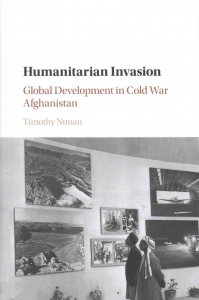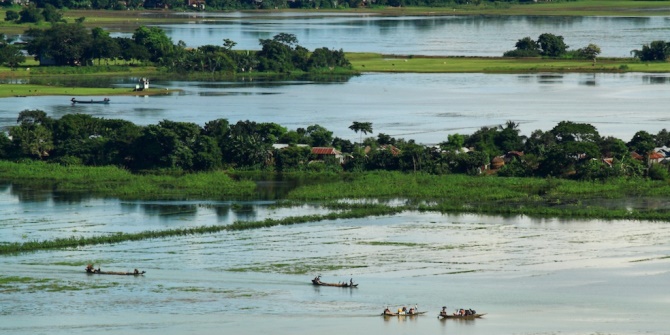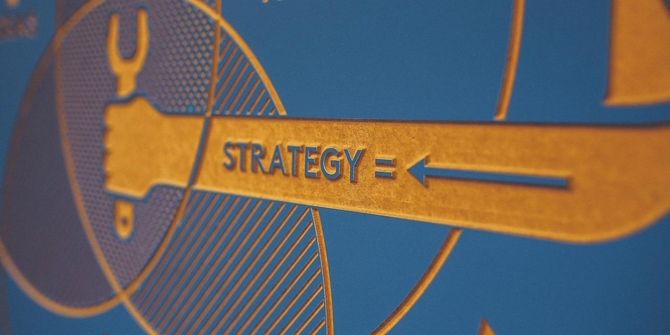 LSE Department of International Relations and the South Asia Centre held an interdisciplinary public roundtable discussion showcasing new research, histories, and perspectives on Afghanistan in international affairs. Dr Timothy Nunan, a scholar of international and global history and one of the speakers at the roundtable, talks to Mahima A. Jain about his research, the ‘humanitarian invasion’ in Afghanistan.
LSE Department of International Relations and the South Asia Centre held an interdisciplinary public roundtable discussion showcasing new research, histories, and perspectives on Afghanistan in international affairs. Dr Timothy Nunan, a scholar of international and global history and one of the speakers at the roundtable, talks to Mahima A. Jain about his research, the ‘humanitarian invasion’ in Afghanistan.
MJ: Why was Afghanistan seen as, in your words, “a laboratory for transnational engagement” and “an object of international politics?
TN: Afghanistan became a laboratory for transnational engagement in the late 1970s and 1980s for several reasons, and for different groups. For many political and technical advisors from the Soviet Union and the Eastern Bloc, Afghanistan was to become a model Marxist-Leninist state for the post-colonial world, much as South Yemen and Cuba had been since the 1960s and countries like Ethiopia, Angola, and the People’s Republic of Kampuchea were more recently. For some Islamists, Afghanistan offered a chance to build an Islamic government that could either build upon the successes of the revolution in Iran or (for some groups backed by Saudi Arabia) become a Sunni sectarian buffer against Iranian influence. And for humanitarians, Afghanistan offered moral clarity as a catastrophe where “white” socialists (the Soviets) were abusing “brown” members of the Third World (Afghans). For all of these groups, Afghanistan’s weak central state infrastructure and porous borders made it easier to make these ideas seem less fanciful than they might have elsewhere.

The two groups that I focus on, the Swedish Committee for Afghanistan and Medecins sans Frontieres, were relatively small operations employing only a few Europeans in Peshawar but then hired hundreds of Afghan doctors or aides to run operations in the country. It is important to add that these were still very much “guerrilla” operations rather than the more professionalized, bureaucratic mode of humanitarian action more familiar to veterans of Kosovo, Iraq, or post-2001 Afghanistan. Further, Peshawar in the 1980s had perhaps the highest number of NGOs anywhere in the world at the time, many of which were run by Afghans, Pakistanis, or Arabs. Additionally, there is the entire story of aid operations run from Iran, which were much more limited than in Pakistan but still significant, since at least a million Afghans fled west to Iran. As far as the problems involved in these humanitarian operations, one–and the reason why my book is called Humanitarian Invasion–was that these humanitarian NGOs were often not very clear about their ultimate stance toward the government of Afghanistan, and whether they wanted to be involved in regime change or not. SCA in particular was clear that its primary goal was to have the Soviets out of Afghanistan, and certainly no documents I have seen suggest that MSF was flirting with the idea of regime overthrow, at least in the early 1980s. However, both of these groups necessarily had to provide their aid to Afghan mujahideen organisations that were against the Soviet occupation and also fundamentally rejected the legitimacy of the post-1978 socialist government.
As long as the Soviets were in Afghanistan, the NGOs and the mujahideen could coexist without fundamentally political questions coming on the table. After the Soviet withdrawal in 1989, however, it becomes more difficult to justify aid to, in effect, one side of an Afghan civil war, especially as the mujahideen groups reject a political settlement that would keep members of the Kabul regime in power. By 1992, when that regime collapsed, the NGOs had in effect been complicit in the overthrow of a socialist Third World government. One need not shed any tears for that regime–which tortured and killed many–to see that this episode would make other authoritarian regimes skeptical of the enmeshing of humanitarian aid with Islamist militias. Think of the White Helmets in Syria, for example, which have been lionised by Western media but denounced as agents of regime change by the Syrian government and its backers. Further, there have been numerous controversies of members of the White Helmets being photographed with Syrian affiliates of al-Qaeda and executions of Syrian Army soldiers.
I take no stance myself on this controversy, but the point is that humanitarian action, which should be neutral and, indeed humanitarian, has been tainted with the stench of regime change and reactionary politics. This, in turn, only causes governments like those in Damascus to attempt to restrict aid to the truly needy or demand that all aid be routed through government or more neutral UN channels.
MJ: What are the misconceptions about the so-called “golden age of Afghanistan” from 1930-1970s? Was it really a golden period?
TN: The middle third of Afghanistan’s twentieth century seems almost like a dream after nearly forty years of civil war and foreign interventions. Indeed, during that period the term “Afghanistanism” was even coined to refer to people devoting too much attention to irrelevant, trivial, or distant problems. Afghanistan was then what countries like Bhutan are today – interesting and rewarding to visit, but certainly not at the centre of world geopolitics. As we saw recently, the US National Security Advisor and Defense Secretary in part convinced President Trump to double down militarily on Afghanistan by showing him pictures of women in miniskirts at Kabul University, as if to say that there is a way back to this “idyll.” I caution against viewing the middle third of Afghanistan’s twentieth century through such rose-tinged classes. In spite of the appearance of “nothing happening,” there were many processes apace during the 1960s and 1970s that contributed to the disaster of the 1980s. I have examined how deforestation was well apace in eastern Afghanistan, which undermined the economies based around Himalayan cedar trees in provinces such as Paktia, Gardez, and Khost. West German forestry experts attempted to save the trees there, but the Afghan government was reluctant to endorse full-blown logging bans that might have prevented the region from the desertification and erosion that was to come in the 1970s and make measures like land redistribution (rather than land development) seem so attractive.
We still need to understand more precisely how the expansion of formal higher education in Kabul as well as branch campuses in the 1960s and 1970s gave frustrated young Afghans coherent ideological frameworks through which they made sense of their worlds. The Faculty of Shari’a Law at the University of Kabul dates to the 1950s, and it was there that professors translated the thought of the Egyptian Islamist Sayyid Qutb into Persian. The broad point, though, is that far from some antediluvian statis, 1970s Afghanistan appears (in retrospect, at least) as a dangerous mix of an unstable regime, a stagnant economy, and radical ideas about social change.
MJ: What are the current prevalent misconceptions among the political class regarding Afghanistan, and does it draw from a limited view of history?
TN: There are several ideas about Afghanistan we see repeated again and again, for example the equivalency of the Taliban and al-Qaeda, or the idea that Afghanistan is fundamentally a Pashtun state whose state institutions need to be given the veneer of Pashtun nationalism. But I would come back to the example of McMaster and Mattis using this idea of oppressed Afghan women as a justification for extension of America’s longest war. For long, Western powers have used women’s rights as a justification for foreign intervention against groups like the Taliban, which are then immediately cast as beyond the pale. So on one level, there is this assumption that relatively recent Western preoccupations such as human rights or women’s rights must guide foreign policy—rather than taking into consideration the balance of power with Russia, Iran, India, and China, say, or simply accepting that some Afghans regard the occupation as illegitimate in spite of efforts toward women’s rights. On another level, it is worth recalling that the tradition of Afghan women’s empowerment that they claim to be defending is not the same as that which the United States imagines itself to be promoting. The “feminism” behind the era of miniskirts was very much a statist illiberal feminism that was then replaced by another statist, illiberal socialist feminism of the socialist government–a socialist government that the USA played a direct role in destroying. Rather than thinking about how we can restore this antediluvian era, I suggest that we might think of the very different traditions of women’s rights and feminism in Afghanistan, and of the debts that the US owes to Afghanistan in light of the 1980s.
MJ: Your next book is The Islamic Factor: Socialists, Islamists, and the Soviet Union in Cold war Eurasia. What role did Afghanistan play in pioneering political Islam?
 TN: My next book project focuses on the competition between the international socialist movement (including the Soviet Union) and the international Islamist movement during the Cold War. Writing Humanitarian Invasion, I was struck by the extent to which Afghanistan in the 1980s was not just a Cold War story and not even just a story about humanitarianism, but also a crucible for a battle between the Marxist, pro-Soviet Left and Islamists of various stripes. For example, many Iranian socialists worked in the cultural bureaucracy of socialist Afghanistan. The states that were most invested in a certain vision of non-sectarian statism compatible with the USSR—Syria, India—were some of the few states to support the Afghan government in the 1980s. At the same time, both Afghan Islamists as well as other groups from the Arab World, Turkey, the Philippines, etc. recognised that Afghanistan could become the kind of “Islamic government” that Islamists outside of Shi’a-majority Iran had failed to achieve. In that sense, Afghanistan is emblematic of a broader struggle between socialists and Islamists, but that we tend to forget today and elide into a clash of civilisations narrative.
TN: My next book project focuses on the competition between the international socialist movement (including the Soviet Union) and the international Islamist movement during the Cold War. Writing Humanitarian Invasion, I was struck by the extent to which Afghanistan in the 1980s was not just a Cold War story and not even just a story about humanitarianism, but also a crucible for a battle between the Marxist, pro-Soviet Left and Islamists of various stripes. For example, many Iranian socialists worked in the cultural bureaucracy of socialist Afghanistan. The states that were most invested in a certain vision of non-sectarian statism compatible with the USSR—Syria, India—were some of the few states to support the Afghan government in the 1980s. At the same time, both Afghan Islamists as well as other groups from the Arab World, Turkey, the Philippines, etc. recognised that Afghanistan could become the kind of “Islamic government” that Islamists outside of Shi’a-majority Iran had failed to achieve. In that sense, Afghanistan is emblematic of a broader struggle between socialists and Islamists, but that we tend to forget today and elide into a clash of civilisations narrative.
The Islamists won this struggle against Afghan socialists, even though the Islamist movement was by and large a failure elsewhere. But as I also try to emphasise in the book, the Islamist movement itself was very soon fractured by sectarian splits between those who viewed Iran as a legitimate leader of the movement, and those who saw Shi’a-majority Iran as an illegitimate interloper. By the end of the 1980s—when Shi’a Islamist groups lost out to Sunni Islamist groups in Afghanistan—Iran itself turned to the Soviet Union as a geopolitical ally. So the story I am attempting to tell is about the impact that this clash between the Left and Islamists has on countries like Afghanistan and the Soviet Union’s fortunes in the Third World, but how it also ironically leads to a rapprochement between Tehran and Moscow against Sunni Islamist groups at the very end of the Cold War. I should stress that I am very much in its early stages of research, and that I draw great inspiration from other scholars of international history such as my colleagues Martin Bayly and Elisabeth Leake as I do so.
This article gives the views of the authors, and not the position of the South Asia @ LSE blog, nor of the London School of Economics. Please read our comments policy before posting.
About The Authors
Dr Timothy Nunan is the Freigeist Fellow at the Freie Universität Berlin and a scholar of international and global history. He tweets @timothynunan
is the Freigeist Fellow at the Freie Universität Berlin and a scholar of international and global history. He tweets @timothynunan
 Mahima A. Jain is blog editor at LSE South Asia Centre. She has a MA in Journalism and has worked as an editor and journalist in India. She tweets @mahima_a.
Mahima A. Jain is blog editor at LSE South Asia Centre. She has a MA in Journalism and has worked as an editor and journalist in India. She tweets @mahima_a.







